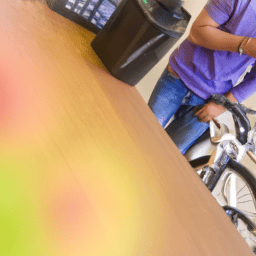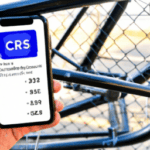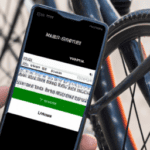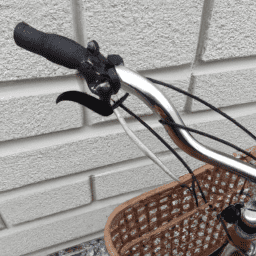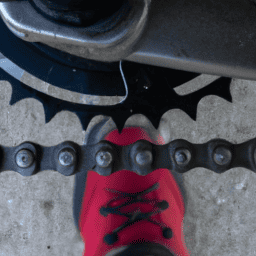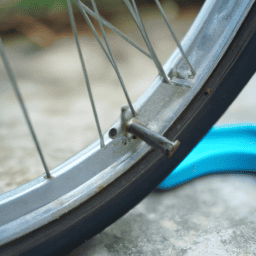Have you ever experienced the theft of your bicycle? This situation can be incredibly aggravating and anxiety-inducing, particularly if your bicycle serves as your main mode of transport or if it carries emotional significance for you.
In fact, according to the National Bike Registry, over 1.5 million bicycles are stolen every year in the United States alone. Knowing how to report a stolen bicycle can increase your chances of recovering it and prevent future theft.
For example, imagine you parked your bike outside a coffee shop for just a few minutes, only to come back and find it missing. Your first instinct may be to panic or feel helpless, but taking immediate action can make all the difference.
By following a few key steps, you can increase your chances of finding your bike and holding the thief accountable. So, whether you’re a daily commuter or a weekend rider, learning how to report a stolen bicycle is an essential skill to have.
Key Takeaways
- Act quickly and report the theft to the police.
- Provide evidence like surveillance footage or witness statements.
- Document the time, location, and distinguishing features of the bike.
- Check local pawn shops and online marketplaces.
Act quickly
Don’t waste any time, if your bike’s been stolen, act quickly and report it to the police using this guide! Contact authorities as soon as possible to report the theft and provide them with any evidence you may have.
This may include surveillance footage, witness statements, or any other information that could help the police locate your stolen bike. Document evidence of the theft, such as the time and location of the incident, as well as any distinguishing features or markings on your bike.
This information can assist the police in their investigation and increase the chances of your bike being recovered. Once you’ve contacted the authorities and documented the evidence, it’s time to gather information about your stolen bicycle.
Gather information
First, you gotta figure out when was the last time you rode your bike. This information is crucial in determining when your bike was stolen and where it may have been taken from.
Once you have established the time frame, you can start gathering information. One of the first things you should do is interview cyclists in the area where your bike was stolen. Ask if anyone saw anything suspicious or if they have any information that could help you recover your bike.
Additionally, you should contact the police and file a report. Provide them with as much information as possible, such as the make and model of your bike, the color, any distinguishing features, and the location where it was stolen. This will increase the chances of your bike being found and returned to you.
After gathering this information, the next step is to check local pawn shops and online marketplaces. This will help you identify if your bike has been sold or traded.
Check local pawn shops and online marketplaces
Next, it’s a good idea to check pawn shops and online marketplaces in the area to see if your bike has been sold or traded. Here are some tips to help you navigate this process:
-
When checking pawn shops, bring along any information you have about your bike, including the make, model, and serial number. This will help the pawn shop identify if they have your stolen bike in their inventory.
-
When checking online marketplaces, search for your bike using specific keywords and filters. Be wary of fake listings or scams, and never meet up with a seller alone or in an unfamiliar area.
-
If you do find your bike for sale, don’t immediately confront the seller. Instead, contact the police and provide them with the information you have gathered. They’ll be able to assist you in negotiating prices and recovering your stolen property.
-
Remember to keep all documentation and evidence related to the theft and recovery of your bike, as this may be helpful if you need to pursue legal action in the future.
By following these steps, you may be able to recover your stolen bike and bring the thief to justice. Once you’ve checked pawn shops and online marketplaces, it’s time to spread the word about your stolen bike.
Spread the word
To increase the chances of recovering your stolen bicycle, it’s important to spread the word as much as possible. Utilize your social media accounts and community networks, such as neighborhood groups and forums, to share information about your stolen bike.
Offering a reward can also motivate people to keep an eye out for your bike and provide any helpful information. Remember to include a detailed description and any unique features of your bike to aid in identification.
Using social media and community networks
Get the word out quickly by posting a message on social media and reaching out to your local cycling group – they can help keep an eye out for your stolen bike and spread the word to others in the community. Utilizing online resources and neighborhood watch programs can also be helpful in spreading the word about your stolen bike. Consider posting on community forums or neighborhood Facebook groups to alert others in your area to be on the lookout for your missing bicycle. In addition, many cities have neighborhood watch programs that can assist in keeping an eye out for suspicious activity and reporting any sightings of your stolen bike.
To further increase the chances of recovering your stolen bike, consider offering a reward for information that leads to its recovery. This can incentivize individuals to come forward with any information they may have about the whereabouts of your bike. With the community’s help and the right resources, there is a high likelihood that you can recover your stolen bike and get back to enjoying your rides.
Offering a reward
Now that you’ve reached out to your social media and community networks, it’s time to consider offering incentives and alerting authorities.
By offering a reward, you can motivate people to keep an eye out for your stolen bicycle and report any sightings or suspicious activity. This reward could be anything from a small amount of money to a gift card or even a meal at a local restaurant.
In addition to offering a reward, it’s important to alert the authorities. This includes filing a police report and providing them with any information you have about the theft, such as the make and model of the bike, any distinguishing features, and the time and location it was stolen.
By involving the police, you increase your chances of recovering your bicycle and holding the thief accountable for their actions.
To prevent future theft, there are several steps you can take.
Prevent future theft
One simple way to deter future thefts is by investing in a sturdy bike lock that’s difficult to cut through. Look for a lock that’s made of hardened steel and has a rating of at least Silver or Gold from Sold Secure, a UK-based certification company.
You can also use two locks, one for the frame and one for the wheels, to provide extra security. Avoid using cheap cable locks as they can be easily cut with bolt cutters.
Another way to prevent future bike theft is by using a bicycle tracking system. This involves attaching a GPS device to your bike that allows you to track its location in real-time. If someone steals your bike, you can quickly locate it and report the theft to the police.
Some GPS trackers also have an alarm that goes off if someone tries to move or tamper with your bike. However, keep in mind that these devices can be expensive and require a monthly subscription fee.
Frequently Asked Questions
How do I file a police report for a stolen bicycle?
To file a police report for a stolen bicycle, visit your local police station and provide all relevant details. Police response may vary, and there may be legal implications if the thief is caught.
Will my insurance cover the cost of my stolen bicycle?
To determine insurance eligibility for your stolen bicycle, check your policy for coverage details and exclusions. If covered, file a claim with your insurer and provide all necessary documentation to expedite the process.
What should I do if I see someone riding my stolen bicycle?
If you see someone riding your stolen bicycle, do not confront the thief. Instead, contact the police immediately. They will advise you on the best course of legal action to take.
Can I track my stolen bicycle using GPS technology?
You’re hoping to recover your stolen bicycle, but GPS tracking may not be the best option. Limitations exist, including battery life and signal strength. Alternative methods include social media, bike registries, and police reports.
How can I increase the security of my bicycle to prevent future theft?
To increase your bicycle’s security, choose a high-quality locking mechanism, such as a U-lock or heavy chain. Store your bike indoors or in a locked shed, and avoid leaving it unattended in public areas. Follow these best practices to prevent future theft.
Conclusion
In conclusion, reporting a stolen bicycle can be a daunting task, but it’s important to act quickly and efficiently. Remember to gather as much information as possible, including the make, model, and serial number of your bike.
Check local pawn shops and online marketplaces for any signs of your stolen bike, and spread the word to friends, family, and local bike shops.
For example, let’s say you park your bike outside of a coffee shop while you grab a quick drink. You come back outside to find that your bike is nowhere to be found. This can be a frustrating and upsetting experience, but it’s important to take action right away.
By reporting your stolen bike and following the steps outlined in this article, you increase your chances of recovering your bike and preventing future theft.
Remember that prevention is key to avoiding bicycle theft. Lock your bike with a sturdy lock and keep it in a well-lit area to deter potential thieves.
By taking these precautions and knowing what steps to take in the event of theft, you can ensure the safety of your bike and enjoy the freedom of cycling without worry.
